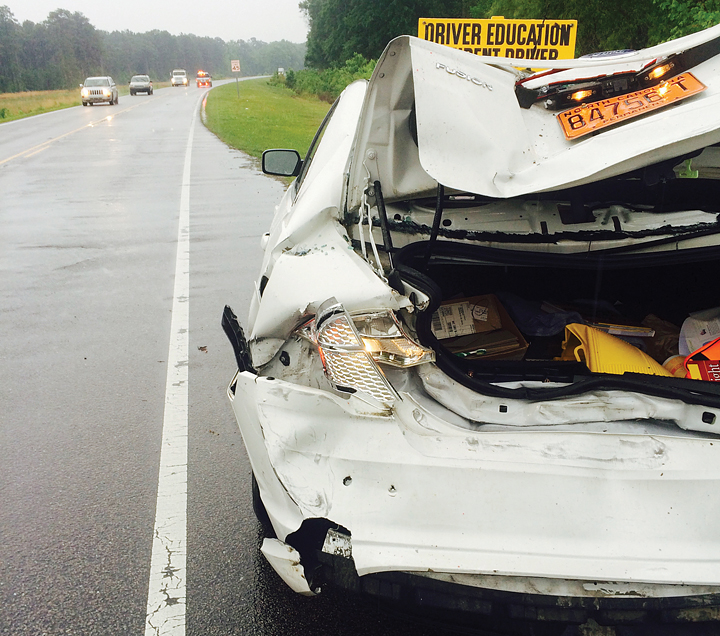Teenage drivers no longer would have to sit through 30 hours of classes or have six hours of teacher-supervised instruction to get their first license under the N.C. Senate’s proposed budget, a provision that worries educators and safety advocates.
The Senate’s budget bill eliminates the driver education requirement for teens under 18. Driver education courses would no longer be available through the public schools, becoming optional rather than required, and by 2016 instruction would shift to community colleges. Teens would have to complete more hours of supervised driving with a parent or guardian and would need a score of at least 85 on the written test to qualify for a provisional license.
The state House and Senate reached a temporary budget deal this week that does not include funding for driver education. The 45-day continuing resolution will be in place until a conference committee can reach a budget compromise.
Meanwhile, at least 43 school districts have suspended their driver education programs, including Brunswick, Columbus, Duplin and Onslow counties in southeastern North Carolina. New Hanover and Pender counties will continue their programs through the summer and then re-evaluate them after the budget is final, information from the N.C. Department of Public Instruction states.
The Senate would allow school systems to charge the full cost of driver education programs, which ranges from $300 to $400 per student, this coming year. Current law requires school boards to cap the fee at $65.
Once the courses move to community colleges, parents probably would have to pay the full cost of instruction. The budget bill requires the programs be self-supporting.
Senate sponsors say eliminating the program could save millions of dollars to use for road construction and other transportation projects. Other states have dropped or considered dropping driver education. Debates have occurred over its effectiveness because there has been no national standard for instruction.
But educators and driver advocates say it would be a huge mistake to eliminate a program that has been shown to make roads safer. In 2012 the Insurance Institute for Highway Safety, an insurers group, reported graduated driver license programs, such as the one that’s been standard in North Carolina, have helped reduce automobile deaths among teenagers. Driver education is a component of that program but would not be if the conference committee that will negotiate the final budget accepts the Senate’s provision.
“I just don’t see the thinking,” said Alan Sewell, who has been teaching driver education at Laney High School for 31 years. He has contacted the state Senate and state House to object to the proposal.
Over the years, he’s helped avert many accidents by inexperienced drivers, he said. Unlike parents, driver education cars feature a set of brakes on the passenger’s side, allowing teachers to stop the car if necessary to prevent a collision. Teachers also are trained to take control of the wheel from the passenger side in an emergency.
Taking the program through schools makes it more convenient, but the real benefit is the quality of instruction they receive, Sewell said. Classes cover assorted safety and driving etiquette issues along indoctrination into the rules of the road.
Many families may have difficulty affording the full cost of a driving program, Sewell said, which may mean fewer students will take the classes. It also can be difficult for parents to teach their own children, and realistically speaking, he said, some parents will sign off without the required hours of driver supervision.
“And they will eventually cost us all, through higher insurance and probably a lot of injuries and fatalities,” Sewell said.
Teens who have not completed a driver education course, either through their school or privately, must wait until they are 18 to apply for their license; no special training is required other than demonstrating the ability to pass the written and driving tests.
If the budget ultimately drops the driver education requirement, Sewell said, “We’re all going to lose.”
New Hanover County is consistently ranked the most dangerous or second-most dangerous county for motorists in North Carolina by AAA Carolinas. Crash and fatality rates affect auto insurance rates for all drivers.
AAA is on record against removing driver education from the graduated drivers license program, said Tiffany Wright, public relations manager for AAA Carolinas.
“We didn’t want to see funding eliminated for driver education — we want funding to be restored,” she said. “Eliminating driver education is not going to help teens, it’s not going to help the entire driving public.”
There is a benefit to getting instruction from teachers who have experience working with children, Sewell said. Teens with learning disabilities need someone who is trained to work with them. One of his instructors, Dale Miller, is an elementary school teacher who specializes in working with children with autism and other disabilities.
But in addition to turning out safer drivers, Sewell, who has a college minor in driver education, said many teachers count on these classes to supplement their paychecks.
“If they drop driver education, I’m retiring,” he said.
email [email protected]




